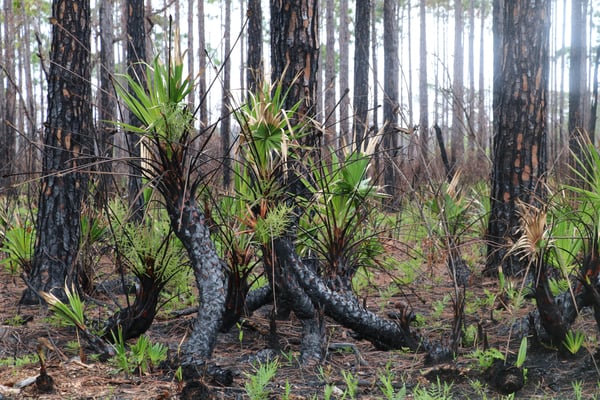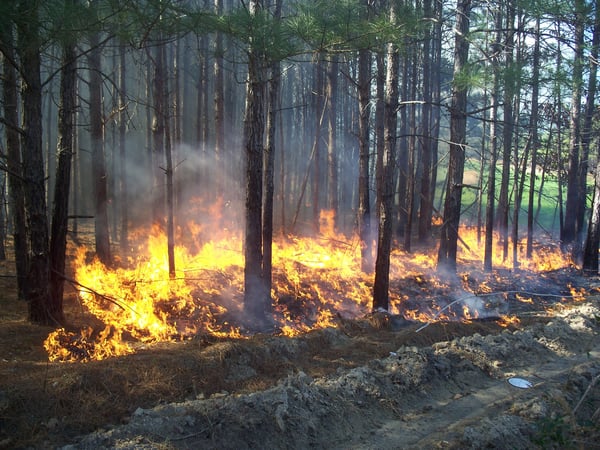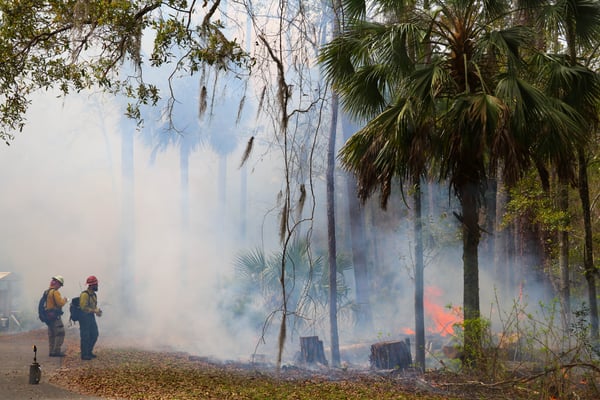How To Do A Controlled Burn In Your Yard
The Benefits of Prescribed Burns:
- Clearing expressionless trees, leaves, branches, and competing vegetation from the wood floor, so new plants can grow and healthy trees can flourish
- Decision-making the amount of bachelor fuel in your woods, to reduce your risk of a dangerous wildfire
- Controlling unwanted trees/plants and invasive species
- Breaking down and returning nutrients to the soil to improve its productivity
- Releasing seeds and stimulating the growth of fire-dependent tree species, such as lodgepole pine
- Promoting wildflower and plant variety
- Improving wood quality for species such as longleaf pino when the lower limbs are "pruned" by the fire
- Controlling some insects and affliction
- Improving wild fauna habitat past enhancing or maintaining open up areas (like prairies or meadows) and encouraging the growth of wild food plants and provender
 |
| The results of a prescribed burn in Crawfordville, FL |
Prescribed Burning for Wildlife Habitat
When author and wild animals biologist Dr. James Dickson enlisted other forestry experts to contribute to his book, Wild animals of Southern Forests, he took note of how many recommended fire for their designated species.
The answer? Many.
The red-cockaded woodpecker, northern bobwhite, American woodcock, reptiles and amphibians, deer, turkeys, and other grass-forb associated birds were amid the long listing of species said to benefit from prescribed fire equally a habitat comeback practice.
When planning a prescribed burn with wildlife in listen, remember that not all fuel is created equal. Southern pine copse for example, typically have thicker, better insulating bark than their hardwood counterparts, which protects them from the heat of the burn. This means that prescribed fire can be very effective at eliminating smaller competing hardwoods.
Having said that, hardwood litter must be much dryer than pine needles in order to carry a burn down. Of course there are exceptions to every dominion, for case the Bur Oak, which evolved in the Prairie systems and developed an insulating bawl. For this reason it's all-time to research the tree species unique to your property earlier planning a burn.
Tips for Conducting a Prescribed Burn:
- There are two seasons for burning. In dormant season (winter) much of a small tree'southward nutrients are beneath ground, so protected from oestrus. Growing season fires have more touch on small trees that are leafed out, but may consume footing nesting bird nests. Flame height and the duration flame is in contact with fuel and trees is the chief determinant of touch.
- Exist sure you take skilful firebreaks. Utilise natural features such as streams or roads when possible, or remove ground litter to exposed soil.
- Back fires backing into the wind are usually ready start. Be certain you get enough consumed fuel and black line to go on the headfire ready afterwards from jumping the firebreak.
- Recommended relative humidity is commonly between thirty-60%. Humidity is normally highest nearly daybreak and lowest mid afternoon.
- Small air current, about 4-12 mph, can move the fire without excessive hazard.
- Tools you lot will need include: a sprayer (capable of 125 pounds-per-square-inch pressure and at least an output of 6 gallons of water per minute,) a drip torch for ignition, a burn rake, flaps, a foliage blower, and a tractor or bulldozer capable of making firebreaks is a nice fill-in.
- Clothing nomex or natural materials, like cotton wool or wool, and leather boots and gloves, because synthetic materials can melt onto your peel and cause burns if they grab fire. It likewise pays to habiliment eye goggles, confront masks, and hard hats.
The best tip nosotros can give is to practise your enquiry and be careful. Find out what permits are required in your country, and become professional help if you lot are new to prescribed burning . Many local forestry agencies offer Learn & Burn events where landowners tin can get first manus experience with prescribed fire before doing information technology themselves.
| |
St. Marks National Wildlife Refuge firefighters executing a prescribed burn in Florida. |
Additional Resources
Below is a list of resources to get you started on understanding and planning a prescribed burn in your region:
Planning & implementing a prescribed burn down (Downloadable Guide from Iowa State University)
Planning & performing a prescribed burn (Video serial from Iowa State University)
Personal Protective Equipment Overview (N Carolina State University eFire interactive site)
The Benefits of Prescribed Burning on Individual State, (Guide from the Minnesota Section of Natural Resources)
Using Fire to Improve Wildlife Habitat (Guide from the North Carolina Cooperative Extension Service)
Association for Fire Ecology (Improves the knowledge and use of fire in land management through science and education)
National Interagency Prescribed Burn Training Center (Their program blends field prescribed burning feel with curriculum of classroom instruction)
Prescribe Fire Councils (Open to all prescribed burners - offers information-sharing and networking opportunities for individuals, agencies, and organizations through almanac or biannual meetings )
Southern Burn down Exchange (Regional program for fire science delivery in the Southeast.)
Tall Timbers (Fire Ecology Program improves direction for conservation of natural ecosystems through scientific inquiry and outreach regarding the role of burn down in natural institute communities)
*This Tip for Landowners was written by Dr. James G. Dickson, award-winning author, researcher, wild fauna biologist, and professor, in collaboration with the American Forest Foundation team. Dr. Dickson, with help from colleagues produced the most comprehensive and honor-winning books on: Wildlife of Southern Forests: Biology and Direction, and The Wild Turkey: Biology and Management. He is Scientist Emeritus, USDA Forest Service, Southern Research Station. Reach him via electronic mail him at jgdickson14@gmail.com.
How To Do A Controlled Burn In Your Yard,
Source: https://info.woodscamp.com/blog/prescribed-fire-tips-and-resources-for-your-first-controlled-burn
Posted by: stoverhoatherand.blogspot.com




0 Response to "How To Do A Controlled Burn In Your Yard"
Post a Comment